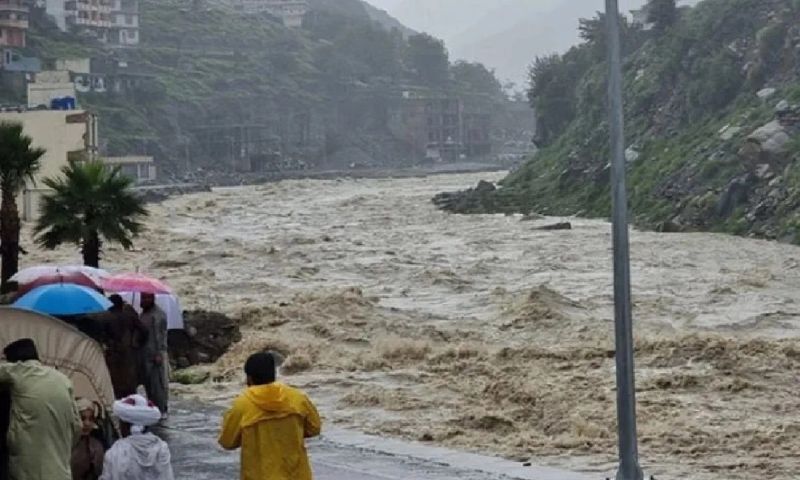KEY POINTS
- NDMA warns of two to three more heavy rainfall spells this monsoon
- Land connectivity has been severed in parts of Gilgit-Baltistan and Khyber Pakhtunkhwa
- Critical dams, including Tarbela, are nearing capacity, heightening flood risks
ISLAMABAD: Pakistan’s National Disaster Management Authority (NDMA) on Sunday warned of two to three more heavy monsoon rainfall spells in the coming weeks, with rainfall expected to be up to 60 percent more intense than the previous years.
Officials say the unusual severity is driven by climate change, raising the risk of widespread flooding and destruction across vulnerable regions.
During a media briefing in Islamabad on Sunday, Chairman NDMA Lieutenant General Inam Haider highlighted that the monsoon’s expansion and severity are largely attributable to soaring summer temperatures that have destabilised atmospheric conditions across multiple regions.
This has resulted in widespread flooding and destruction, notably in Buner, Bajaur, and Battagram districts, which are increasingly vulnerable to climate-induced hazards.
“The monsoon season is expected to persist until September 10,” Lt Gen Haider stated, emphasising the ongoing threat.
He detailed that land connectivity has been severed in several areas of Gilgit-Baltistan and Khyber Pakhtunkhwa due to flash floods and landslides.
Search and rescue operations are actively underway for missing persons, while relief efforts—including dispatching essential supplies—are being prioritised to affected districts.
Restoration of damaged infrastructure is underway, with a focus on reconnecting isolated communities, the disaster management authority chairman said.
The NDMA is working in close coordination with provincial authorities to ensure swift assistance, and additional relief packages are scheduled for delivery to the hardest-hit regions early next week, the authority chairman said.
The NDMA chief underscored the importance of proactive measures, including evacuations in vulnerable zones and restoring communication networks in cut-off areas through specialized technical teams.
Post-monsoon rehabilitation plans are also being formulated in collaboration with the Ministries of Communications and Housing to rebuild damaged infrastructure.
Lieutenant General Haider attributed recent devastation in northern districts to the intensifying impacts of climate change, warning that northern Punjab and northern Khyber Pakhtunkhwa could face even more severe rainfall in the days ahead.
He assured that the NDMA, alongside relevant ministries and armed forces, remains committed to ongoing relief and rehabilitation efforts, with regular updates to help mitigate future risks.
The armed forces continue to play a vital role in rescue operations, with a comprehensive survey underway to assess the full extent of losses. Relief camps are being established where necessary to support displaced communities.
Earlier briefings outlined a detailed monsoon contingency plan, identifying northeastern regions—including Azad Jammu and Kashmir and central Khyber Pakhtunkhwa—and southeastern districts such as Tharparkar, Sujawal, and Badin as particularly vulnerable to intensified rainfall and flooding.
The convergence of three major weather systems over Pakistan is expected to significantly amplify rainfall across the country.
Technical experts from NDMA, including Dr. Tayyab Shah, forecast that the current rainfall sequence will continue until August 22, with further intensification anticipated.
A new monsoon spell is expected to follow, driven by systems approaching from the Bay of Bengal and Afghanistan’s Nangarhar and Kandahar regions.
Water levels at critical dams and bridges are rising rapidly; Tarbela Dam is currently at 98 percent capacity and may reach a critical threshold soon.
Flood risks are particularly high in areas along the Koh-e-Suleiman Mountain range, as well as in districts of Azad Jammu and Kashmir and Khyber Pakhtunkhwa, including Peshawar, Chitral, Dir, and Charsadda.
Preparations for the monsoon season began early this year, with proactive measures undertaken in coordination with provincial authorities.
Nonetheless, recent cloudbursts have caused tragic loss of life, reporting 344 fatalities and 178 injuries over the past two days.
The military and Frontier Corps remain actively engaged in rescue efforts, with additional relief supplies scheduled for dispatch to Buner on Monday.






















